A motorcycle helmet is the most important safety equipment you can wear as a rider. But ever wondered how on earth these life-saving helmets are made?
This piece of protective equipment has saved countless lives over the years. And here’s how a motorcycle helmet is made-
Motorcycle helmets are made with a hard layer on the outside and impact-absorbing foam-type material from the inside. This formula is so effective that almost all the helmets out there are made in a similar manner, more or less. Scroll down to find out more details!
How is a motorcycle helmet made?
In simple terms, different helmet parts such as shell, liner, and other parts are made separately in factories; and assembled. The outer shell is usually made of polycarbonate, fiberglass, and carbon fiber. And the EPS liner is Expanded Polystyrene which is similar to styrofoam material. The making process varies from brand to brand but that’s how a motorcycle helmet is made more or less. All motorcycle helmets have to meet some sort of safety regulations to be road legal. |
You’ll need a DOT-certified helmet to ride a motorcycle in the US, while you’ll need an ECE-certified helmet in Europe. The helmets you see in MotoGP are usually made of lighter and premium materials, suitable for racing.
What is a motorcycle helmet made out of?
A good motorcycle helmet is made out of a few different parts that all serve the purpose of protecting your head. There is the outer shell that is hard and protects your head from outer impact. The inner safety EPS liner serves as a cushion inside the helmet. Depending on the brand or type of helmet, some might have a few parts more but here are the main parts a typical motorcycle helmet has.
1. Shell
A shell is the most outer part of the helmet. It’s the hard layer that is usually made of polycarbonate or fiberglass and it saves your head from outer impact or materials. It’ll make sense if you compare it with a snail. The outer ‘shell’ of a snail is a protective layer that saves its life. The same goes for the ‘shell’ of the helmet. There’s even a safety certification named SNELL, which is pretty reliable for helmet safety.
The most popular motorcycle helmet shell material is polycarbonate. However, there are also helmets that are made with fiberglass or carbon fiber. Some are even handwoven for perfection, that’s how Shoei helmets are made. These are pretty much the materials used to make shells-
- Polycarbonate
- Fiberglass
- Carbon fiber
- Kevlar
- Composite fiber
- Thermoplastic resin
- ABS or Acrylonitrile butadiene styrene
- And more
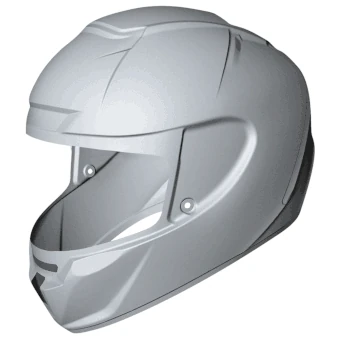
2. EPS liner
EPS or Expanded Polystyrene is a styrofoam-type material that sits between the outer shell and the comfort padding. It’s a crushable foam material that saves your head from impact within the helmet. It’s more like a soft (at least not hard) cushion that reduces the impact energy in a crash.
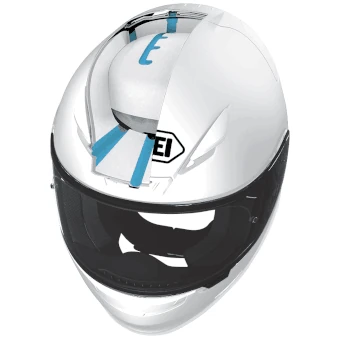
The universal truth applies here as well, premium helmets have better-quality EPS liners. Some EPS liners are ventilation friendly as there are air channels through the liner. Air usually intakes from the front vents passes through the EPS liner and cools down the interior of a helmet. Take the Shoei RF-1400 helmet for example. This helmet even got a multi-layered EPS liner that has better impact absorption quality. And as an impact-absorbing material, the EPS liner does wear out over time. That’s why the pros recommend replacing the helmet once every five years, even if the helmet looks fine from the outside.
3. Comfort liner and paddings
Comfort liner and paddings are the last layer inside a motorcycle helmet that touches your skin. It’s the padding designed for the human head shape inside the helmet. It’s important to check the fitting of the helmet before you buy one, and comfort liner plays a vital role here. It’s also important that you get the head shape and size right because a wrong-sized helmet can be super annoying. You can repair the motorcycle helmet liner but it’s often easier to just replace it.
Many helmets have adjustable comfort liners that you can adjust while getting a new helmet. However, you should always check your head shape first and then buy a motorcycle helmet. Another interesting part of the comfort liner is the cheek pads. The right size cheek pads can give you the most comfortable ride ever on the other hand wrong size will give you hell. Some helmets such as the LS2 Blaze have an emergency cheek pad release system. This feature makes it easier for the emergency medical team to remove the helmet easily. This is a pretty handy feature that might save your life one day.
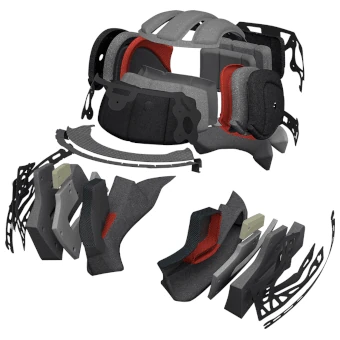
4. Face shield & visors
Face shields are clear plastic cover that protects the rider’s eyes from wind and dust. You’ll see this face shield in most helmets but some open-face and half helmets might come without one. And some people absolutely love helmets without a face shield but it’s not that practical when you are riding at speed.

However, there’s a pretty common issue among motorcycle riders, and I’m sure you might’ve already faced it. It’s the fogging-up issue, the lens or the face shield fogs up due to warm breath and imbalance temperature inside and outside the helmet. Some companies found their own solutions to that problem which are mostly some sort of anti-fog coating. But one solution works as a charm, and that is the Pinlock anti-fog lens. It’s an extra layer you add to your face shield that prevents flogging. Some helmets ship one included with the helmet, take the Shoei RF-SR for example.
5. Chin strap
The strap on a helmet does a pretty simple yet important job. The thing holds the helmet over your head and prevents it from falling off. It might seem not that big of a deal but what’s the point of having a giant helmet over your head only to fall off just before you hit your head? I saw the exact same thing happening to a guy and the result wasn’t that pretty. So, dudes and gals, keep the strap closed whenever you ride.
The strap also can be a bit uncomfortable sometimes, so some helmets have some sort of padding on them. There are two types of straps available,
- Quick-release strap
- Double-D ring strap
They both are fine, you should go for whichever, you feel comfortable with. You can even change or fix the chin strap type if you like.
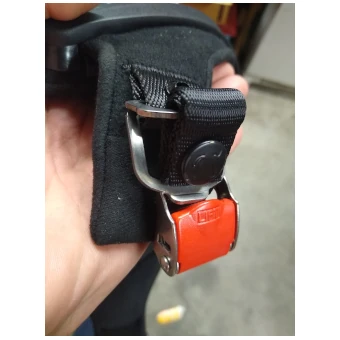
Motorcycle helmet manufacturing process
Like any other product, the motorcycle helmet manufacturing process also varies from brand to brand. However, the core concept of the helmet manufacturing process is somewhat the same. They make all the other parts separately and put them all together. And here’s what happens in a motorcycle helmet manufacturing factory, more or less-
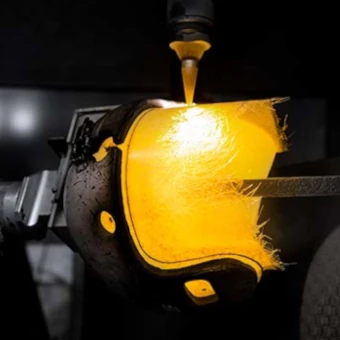
- The Shell is made
- The Shell’s quality is checked
- The helmet (shell) is painted
- Stickers and decals are applied
- The EPS liner is made
- EPS liners and comfort liners are added
- Other parts are added to the helmet
- Overall quality check
- Pack and send it to the store
Regardless of how a motorcycle helmet is made, all things expire. Check out how long a motorcycle helmet is good for.
FAQ (Frequently Asked Questions)
No, a motorcycle helmet is not bulletproof. The materials a motorcycle helmet is made of are not suitable for resisting a bullet fired from a gun. A motorcycle helmet was made to prevent head injury from an accident, not to stop a bullet.
A DOT certification makes a helmet road legal in the United States. However, whether you have to wear a helmet while riding a motorcycle depends on the helmet laws of the state you are in. And a helmet is legal if it meets ECE standards in Europe and JIS in Japan.
You should wear a motorcycle helmet to prevent any chance of injury if you happen to be in a road accident on a motorcycle. In 2020, 57% of motorcycle riders killed in road accidents in states without universal helmet laws were not wearing helmets. While the percentage is 11% in the states where the universal helmet law is applicable. Look at the matrics and you decide whether you should wear a helmet or not, but every motorcycle enthusiast will say you should, period.
Conclusion
Motorcycle helmets are safety gears that protect a rider’s head during a crash. They are made in a way so that they can resist the impact of a crash and save your head. There are countless cases where motorcycle riders are saved because they had a good helmet on their head. And if you were curious about how they were made, this post will answer your questions. And if you still have some questions left unanswered, be sure to let us know.
Also, check out our post about the average weight of a motorcycle helmet. Have a good day!
